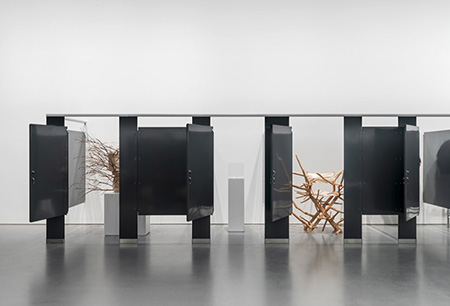
Continuing through January 6, 2024
Has the glut of immersive experiences — everything from your Van Gogh or Monet “immersive,” to the recent opening of The Sphere, in Las Vegas — had any impact on high-end gallery art? With painting’s continued domination, it doesn’t appear so. But for any artist who puts at least as much stake in the installation as a whole into each of the individual works, it seems possible that there’s a correlation. Hugh Hayden’s installation-cum-sculpture show, “Hughman,” couldn’t be further from what constitutes immersive art. In an unlikely collision of minimalism and maximalism Hayden transforms the main gallery into a memorable installation that immerses us in such a way that we control the tempo of that immersion, as opposed to a series of screens doing all the immersing for us.
“Hughman” rims the perimeter of the gallery with a wall of more than 20 pristine, gray toilet stalls, each with a door bolt indicating the green dial of accessibility — except for one dial that’s red (the only stall you can’t enter). Viewers open each stall door to encounter a mini-exhibit featuring anywhere from one to four works before moving on to the next one. Each stall opening reveal is ultimately the greatest triumph of the show; to whatever extent it’s simple novelty is up to each viewer. For me it worked as a simple yet fresh new way of framing and experiencing art in a quintessential white cube, where that white cube has been transformed with great economy.
What meets you inside each stall is a wide range of (mostly) sculptural whimsy of varying sizes and configurations. It’s part Charles Ray, part Robert Gober and a dusting of Cady Noland, yet also an ample introduction to Hayden’s own vision.
His reach extends across colonialism and slavery, gun culture and toxic masculinity, traditional craft and industrial fabrication, all with an equally varied touch. That touch ranges from the hyperbolic (guns jutting from male groins) to the esoteric (a toilet seat covered in cleaning bristles). One of the first pieces you encounter (if you open the stall doors clockwise around the gallery) is a canvas-backed director's chair with a wild protrusion of carved wood extensions sprouting from its arms, legs and back, at the tips of which are carved penises. Titled “The Audition,” it nails (so to speak) an old Hollywood ritual with the handmade, a style Hayden similarly employed in a sculpted ladder that was included in a group show, “The Emerald Tablet,” at Jeffrey Deitch in 2021. Amid the wide breadth of sculptural styles, this feels the closest to a signature style.
“Madonna and Child” is a six-foot-tall basswood sculpture made with a CNC machine. The artist wears a ball cap and holds a large dog; he’s a hunter but also a domesticator. The representational quality of the work falls into the derivative trap — a bit too much Charles Ray. A series of urinals — bearing the obvious lineage of Duchamp — are less tied to their source. Perhaps it is the way in which they more thoroughly meld with the bathroom-stall install. The ambiguous washroom at the entrance to the gallery, meanwhile, with its hyper-contemporary sink and shiny aluminum trash can, morphs from art into life and back into art again.
Amidst this wealth of potent sculptures, it’s actually a pair of photos in one of the more packed stalls that are the most powerful, and provocative, individual works. “Colonizer (vertical)” and “Colonizer (horizontal)” feature two men — one black, the other white — with impregnated bellies, each being held lovingly by their respective partner. Their oddness in the context of the sculptures really makes them resonate. They’d be far less remarkable on their own as part of a more conventional display of photographs. But ultimately, it’s the bespoke experience of opening a plethora of bathroom stalls to yet another miniature exhibition that’s the real gift of this show. It’s that process, that experience, that holds sway long after the dust of experiencing “Hughman” has settled.
